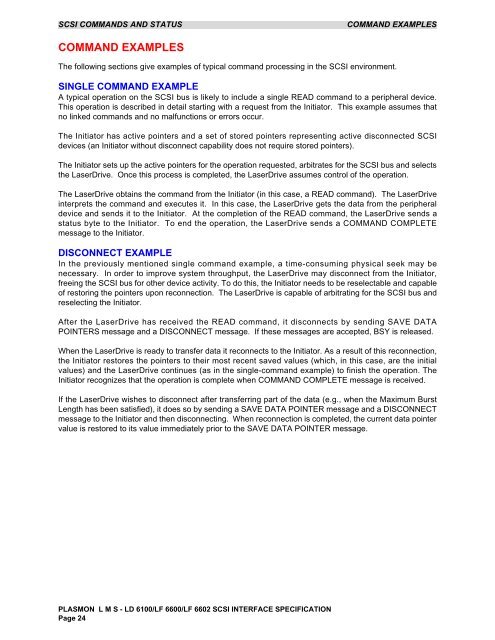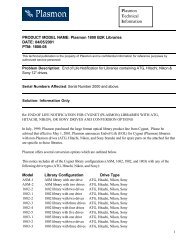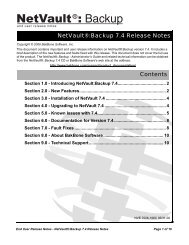scsi interface specification - Plasmon
scsi interface specification - Plasmon
scsi interface specification - Plasmon
Create successful ePaper yourself
Turn your PDF publications into a flip-book with our unique Google optimized e-Paper software.
SCSI COMMANDS AND STATUS COMMAND EXAMPLESCOMMAND EXAMPLESThe following sections give examples of typical command processing in the SCSI environment.SINGLE COMMAND EXAMPLEA typical operation on the SCSI bus is likely to include a single READ command to a peripheral device.This operation is described in detail starting with a request from the Initiator. This example assumes thatno linked commands and no malfunctions or errors occur.The Initiator has active pointers and a set of stored pointers representing active disconnected SCSIdevices (an Initiator without disconnect capability does not require stored pointers).The Initiator sets up the active pointers for the operation requested, arbitrates for the SCSI bus and selectsthe LaserDrive. Once this process is completed, the LaserDrive assumes control of the operation.The LaserDrive obtains the command from the Initiator (in this case, a READ command). The LaserDriveinterprets the command and executes it. In this case, the LaserDrive gets the data from the peripheraldevice and sends it to the Initiator. At the completion of the READ command, the LaserDrive sends astatus byte to the Initiator. To end the operation, the LaserDrive sends a COMMAND COMPLETEmessage to the Initiator.DISCONNECT EXAMPLEIn the previously mentioned single command example, a time-consuming physical seek may benecessary. In order to improve system throughput, the LaserDrive may disconnect from the Initiator,freeing the SCSI bus for other device activity. To do this, the Initiator needs to be reselectable and capableof restoring the pointers upon reconnection. The LaserDrive is capable of arbitrating for the SCSI bus andreselecting the Initiator.After the LaserDrive has received the READ command, it disconnects by sending SAVE DATAPOINTERS message and a DISCONNECT message. If these messages are accepted, BSY is released.When the LaserDrive is ready to transfer data it reconnects to the Initiator. As a result of this reconnection,the Initiator restores the pointers to their most recent saved values (which, in this case, are the initialvalues) and the LaserDrive continues (as in the single-command example) to finish the operation. TheInitiator recognizes that the operation is complete when COMMAND COMPLETE message is received.If the LaserDrive wishes to disconnect after transferring part of the data (e.g., when the Maximum BurstLength has been satisfied), it does so by sending a SAVE DATA POINTER message and a DISCONNECTmessage to the Initiator and then disconnecting. When reconnection is completed, the current data pointervalue is restored to its value immediately prior to the SAVE DATA POINTER message.PLASMON L M S - LD 6100/LF 6600/LF 6602 SCSI INTERFACE SPECIFICATIONPage 24














